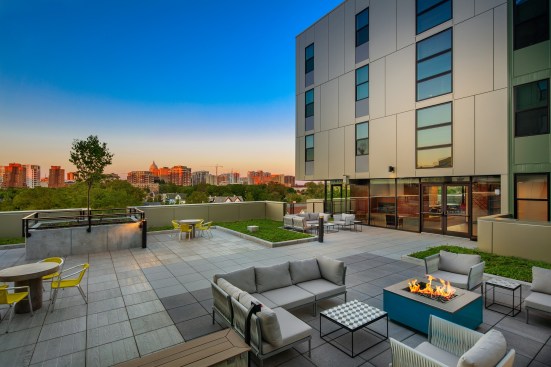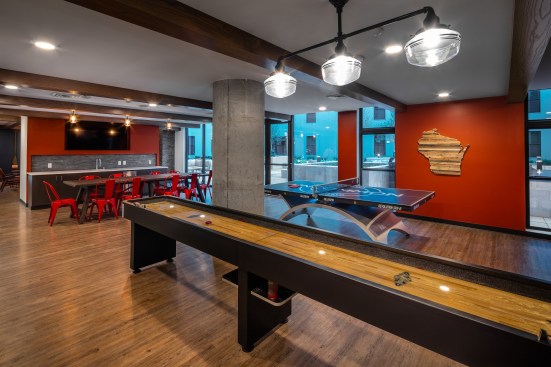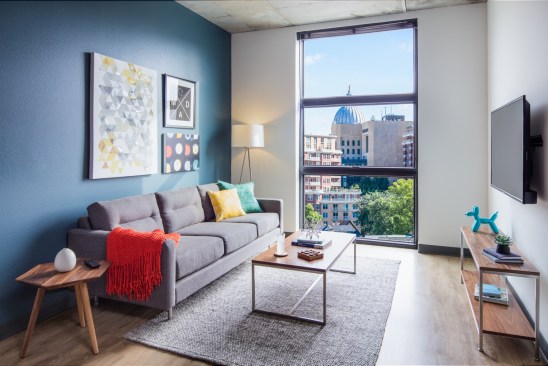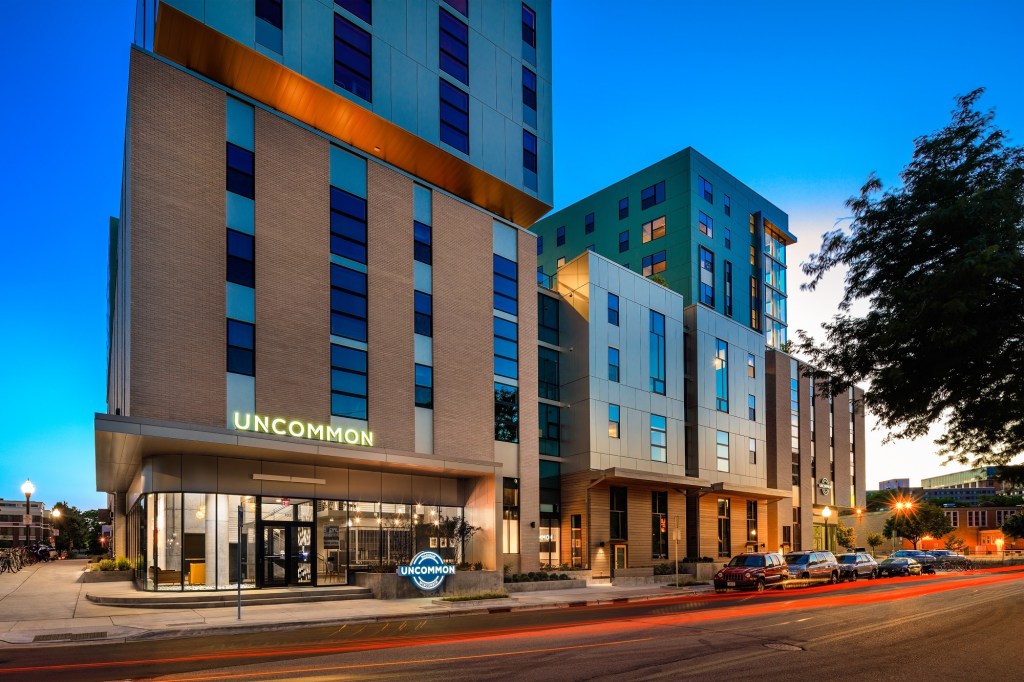Formerly the site of a cardboard factory, an almost–1 acre, irregularly shaped lot in Madison, Wis., appealed to Chicago-based developer CA Ventures for multiple reasons: It was located downtown and adjacent to the bustling, bucolic University of Wisconsin campus; the city had changed its zoning laws so taller structures could be built; and a dearth of good housing would help a new building attract students as well as young professionals and empty-nesters wanting to be downtown.
The developer’s first tasks were to buy the property from Phoenix Too LLC in October 2014, demolish the factory, remediate the lot, and then construct a 10-story building, the first that high since the rezoning.
Listen to the Neighborhood
The university has long been known for having a highly vocal student body, but the area residents and city leaders, too, make themselves heard. CA Ventures learned that the city wanted new buildings to be visually exciting, says Melissa Huggins, a principal at Urban Assets, a local urban planning firm. Yet, residents didn’t want a tall structure to overshadow small homes or cause traffic congestion.
“We listened to what was said, long before we put pen to paper,” says developer Ryan Sadowy, senior project manager. His firm brought in Shepley Bulfinch, an architecture/design firm with multiple offices, to balance hipness with respect for the mix of historic and quirky neighborhood icons, says Shepley project architect Tom Chinnock.
Go Green in Color and Efficiency
The Uncommon Madison, which opened for leasing this past August, fits its name well. Because of adjacent buildings, Chinnock and colleagues designed it in a mix of heights—some stepped back—and with different styles and materials on the façade. One tall side echoes its busy streetscape while a shorter one has porches and a faux wood composite front to resemble nearby houses. (The faux wood is a novel material known as Resysta that’s made from rice husks, rock salt, and plastic polymer and that’s extremely durable and sustainable.)
Other materials and detailing produce the overall effect of trees because of muted brick tones at the base that suggest trunks and green metal panels above that replicate leafy canopies. Some neoclassic curved corners pay homage to older campus buildings.
Tailor Amenities to the Cohort
To compete with The Hub, another new area student building packed with amenities, CA incorporated bells and whistles but held back to differentiate the project and appeal to its sophisticated clientele. “We didn’t go Animal House crazy with hot tubs, volleyball courts, and pools,” says Sadowy. What fit: fitness and business centers; clubrooms with fireplaces; two courtyards on different levels, with one on a higher floor oriented toward the state capitol building; parking for cars, bicycles, and mopeds; and display space for student artwork.

Matthew Dula Photography
Two outdoor courtyards on different levels offer a respite from studies and work.
The firm also wanted to engage its neighborhood, doing so with Cafe Social, a coffee/pastry shop owned by local residents and visible through big storefront-style windows. Interior designer and architect Sarah Tocci balanced rustic and modern choices for a novel look, with gray laminate cabinets and blue accent walls in the apartments, and furnishings that pair resin chairs with classic wood bases or wingback chairs with modern plaid upholstery.

Matthew Dula Photography
A game room is one of many amenities for residents' enjoyment.
Landscaping was another integral feature. Plantings soften the busy site and seat walls provide nice perches. In the courtyards, plants attenuate sound, offer four-season interest, and give those in higher units views down, says landscape architect Joe Porter of Ken Saiki Design in Madison.
Build in Flexibility
With its in-depth knowledge of student housing, CA incorporated a mix of apartments—from 400-square-foot studios to 1,394-square-foot four-bedrooms. Some layouts incorporate bunk beds for two to share a room and pare costs. The firm also constructed seven live/work townhouses facing the more-residential street, which rent for as much as $1,569 a month, the costliest in the building; double-occupancy bedrooms are the least expensive, at $609 a month.

Matthew Dula Photography
Units at Uncommon Madison range from 400-square-foot studios to 1,394-square-foot four-bedrooms. Seven live/work townhomes are also available.
And for extra flexibility, 17 of the studio units have a wall that separates the living area from the bedroom and features a large-screen TV with a built-in gaming/video console that rotates 180 degrees so that either side can access it.
CA always makes reducing a building’s carbon emissions a priority through its choice of materials, appliances, and HVAC systems. Uncommon Madison also represents a TOD location with a bus stop out front. Since leasing began last August, the building is 94% occupied.
